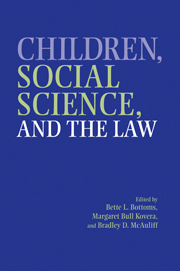Book contents
- Frontmatter
- Contents
- Acknowledgments
- Contributors
- 1 Children, Social Science, and the Law: An Introduction to the Issues
- PART I CHILDREN'S RIGHTS, THEIR CAPABILITIES, AND SOCIETY'S RESPONSIBILITIES TO CHILDREN
- PART II CHILDREN AND FAMILY CHANGE
- PART III JUVENILE AGGRESSION AND JUVENILE JUSTICE
- PART IV CHILDREN AS VICTIMS AND WITNESSES
- 12 The Effects of Community Violence on Children and Adolescents: Intervention and Social Policy
- 13 Preventing Child Abuse and Neglect
- 14 Children's Eyewitness Memory: True Disclosures and False Reports
- 15 Expert Testimony on the Suggestibility of Children: Does It Fit?
- 16 The Status of Evidentiary and Procedural Innovations in Child Abuse Proceedings
- PART V CONCLUSIONS AND FUTURE DIRECTIONS
- Author Index
- Case Index
- Subject Index
- References
13 - Preventing Child Abuse and Neglect
Published online by Cambridge University Press: 24 July 2009
- Frontmatter
- Contents
- Acknowledgments
- Contributors
- 1 Children, Social Science, and the Law: An Introduction to the Issues
- PART I CHILDREN'S RIGHTS, THEIR CAPABILITIES, AND SOCIETY'S RESPONSIBILITIES TO CHILDREN
- PART II CHILDREN AND FAMILY CHANGE
- PART III JUVENILE AGGRESSION AND JUVENILE JUSTICE
- PART IV CHILDREN AS VICTIMS AND WITNESSES
- 12 The Effects of Community Violence on Children and Adolescents: Intervention and Social Policy
- 13 Preventing Child Abuse and Neglect
- 14 Children's Eyewitness Memory: True Disclosures and False Reports
- 15 Expert Testimony on the Suggestibility of Children: Does It Fit?
- 16 The Status of Evidentiary and Procedural Innovations in Child Abuse Proceedings
- PART V CONCLUSIONS AND FUTURE DIRECTIONS
- Author Index
- Case Index
- Subject Index
- References
Summary
In terms of numbers alone, child maltreatment is a significant social problem. Although recent studies suggest that rates of some types of maltreatment, especially sexual abuse, have decreased markedly in the last decade (Jones & Finkelhor, 2001), overall many children are harmed each year. For example, using a standard of “demonstrable harm as a result of maltreatment,” it has been estimated that 1,553,800, or 23.1/1,000 children, were victims of maltreatment during 1993 (U.S. Department of Health and Human Services, 1996, pp. 2–9).
In this chapter, we review some examples of newly developed programs, community-based initiatives, and recent legislation designed and implemented to prevent child maltreatment. In this context, we find that although there have been some successes, such programs and legislation are as likely to have been driven by values, biases, and political considerations as they are to have been driven by a research-based understanding of the problem. Stated differently, there tends to be a gap between what we know empirically about prevention and what ultimately gets implemented. We conclude the chapter with some comments about how social scientists might help bridge this gap.
PREVENTING CHILD ABUSE AND NEGLECT
The U.S. Advisory Board on Child Abuse and Neglect (ABCAN) (1990) described the problem of child maltreatment and the system developed to help solve that problem as a national emergency. In a subsequent report, they called for a preventive strategy that would be “comprehensive, child-centered, family-focused, and neighborhood-based” (U.S. ABCAN, 1993, p. 16; see Small & Limber, this volume).
- Type
- Chapter
- Information
- Children, Social Science, and the Law , pp. 322 - 341Publisher: Cambridge University PressPrint publication year: 2002
References
- 2
- Cited by



